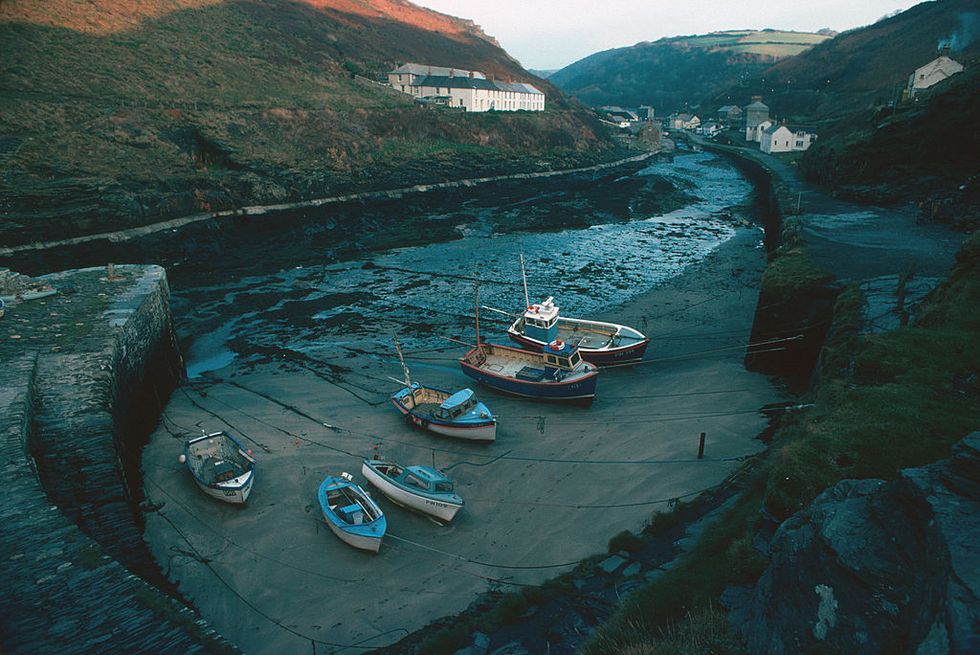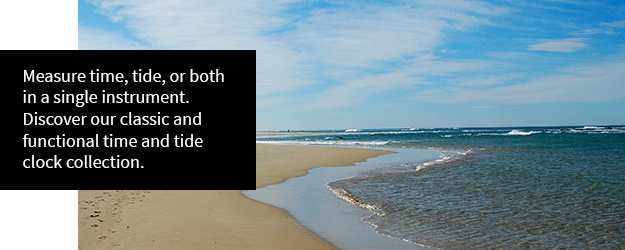What Are Tides and How Do They Work?

Both high and low tides are caused by the Moon and its gravitational pull. As the Earth rotates, the Moon’s gravity pulls on different parts of the planet, even the land in very small amounts. While the Moon cannot easily pull the land of the Earth, water has a much easier time moving around and is naturally drawn in the direction of the Moon, causing water to “bulge out” on the sides of the Earth that are closest to and furthest from the Moon. This is called the tidal force, and those opposite “bulges” of water are high tides. Tides are one of the most reliable phenomena in the world. As the sun rises in the east and the stars come out at night, we know that ocean waters will regularly rise and fall along our shores.
Tides are very long-period waves that move through the ocean in response to the forces exerted by the moon and sun. Tides originate in the ocean and progress toward the coastlines where they appear as the regular rise and fall of the sea surface. Let’s dig a little deeper into how tides work, what causes them, and how you can use a time and tide clock at home to monitor them.
Key Takeaways
- The Moon’s gravity creates predictable ocean bulges we experience as tides.
- Tidal patterns vary across different coastlines worldwide.
- Tides deeply influence maritime cultures, navigation, and traditions.
- Modern tide clocks bring this essential knowledge into your home.
How Do Tides Work?
Tides change through four phases:
- Flood Tide: When Sea level rises over several hours, covering the intertidal zone.
- High Tide: When the water rises to its highest level.
- Ebb Tide: When Sea level falls over several hours, revealing the intertidal zone.
- Low Tide: When water ceases to fall.
The currents produced by tides are called “tidal streams.” The moment this tidal current stops pulling and the water ceases, it is called a “slack tide” and indicates the impending reversal of the tide.
What Causes High and Low Tide?
When the highest part, or crest, of the wave reaches a particular location, high tide occurs; low tide corresponds to the lowest part of the wave, or its trough. The difference in height between the high tide and the low tide is called the tidal range.
While tidal force is distributed similarly at the closest and farthest points of the Earth, in real life, the Earth isn’t all ocean or covered in an even layer of water. Continents get in the way, preventing the water from perfectly following the Moon’s gravitational pull. Therefore, in some locations, there is not much difference between high and low tides, but in others, the difference is dramatic.
Just like the Moon, the Sun also causes tides — though to a lesser extent. When the Earth, Moon, and Sun line up (such as during full or new moons), the solar and lunar tides reinforce one another. This leads to more extreme tides, also known as “spring tides.”
Tide Symbolism: Cultural Significance of Tides
Throughout human history, the rhythmic rise and fall of tides have deeply influenced coastal communities, shaping not just their daily activities but their cultural identities as well. Many ancient civilizations viewed tides as powerful symbols of life’s natural cycles, representing themes of renewal, cleansing, and the passage of time.
In Celtic traditions, tides were often associated with the breath of a sleeping sea deity, while Pacific Island cultures incorporated tide patterns into their navigation techniques, enabling remarkable ocean voyages using only natural observations. The Haida people of the Pacific Northwest developed elaborate ceremonies timed with specific tidal cycles, believing these moments created special connections between the human and spirit worlds.
Tides appear prominently in literature and art across cultures. Japanese woodblock prints often feature dramatic tidal imagery, while countless poems and stories use tides as metaphors for life’s inevitable changes. The phrase “time and tide wait for no man” reminds us of nature’s unstoppable rhythms that continue regardless of human desires.
Even today, many coastal communities maintain traditional ecological knowledge about tides, using specific terminology to describe different tidal states and associated weather patterns. Fishermen might speak of “neap tides” as poor fishing times, while clam diggers know precisely when certain beaches will yield the best harvest.
This cultural connection to tides represents a fascinating blend of practical knowledge and spiritual significance. While modern science explains the gravitational forces behind tides, the human experience of living with these daily rhythms continues to inspire art, language, and tradition in coastal communities worldwide.
For those interested in connecting with this aspect of maritime heritage, a tide clock serves as more than just a practical tool. It’s a reminder of humanity’s enduring relationship with the ocean’s eternal patterns.
What Are Tidal Bores?
A fascinating tidal phenomenon occurs in certain rivers worldwide where incoming tides create a visible wave traveling upstream against the river’s current. Notable examples include the Qiantang River in China (locally called the “Silver Dragon”), the Amazon’s pororoca, and the Severn Bore in England. These natural events have become tourist attractions and even sporting venues where surfers ride the incoming wave for kilometers upriver. Tidal bores only form in specific conditions where the incoming tide is funneled into a narrowing river channel with the right depth and flow characteristics.
How Frequently Do Tides Rise?
While everyone is familiar with the standard 24-hour solar day, high and low tides operate on a lunar day which is 24 hours and 50 minutes long. The lunar day is 50 minutes longer than a solar day because the moon revolves around the Earth in the same direction that the Earth rotates around its axis. That means it takes the Earth an extra 50-minute to “catch up” to the moon.
Because the Earth rotates through two tidal “bulges” each lunar day, most coastal areas experience two high and two low tides every 24 hours and 50 minutes. High tides occur every 12 hours and 25 minutes apart. It takes 6 hours and 12.5 minutes for water at the shore to go from high-to-low or from low-to-high.
Tidal Anomalies and Unusual Tidal Patterns
While most coastal areas experience the standard semidiurnal tide pattern (two high and two low tides daily), some regions around the world have unique tidal behaviors. The Gulf of Mexico experiences diurnal tides, with one high tide and one low tide each day, while parts of Southeast Asia have mixed tides. These anomalies occur due to the shape of coastlines, ocean floor topography, and the Coriolis effect. Understanding these variations is important for boaters, fishermen, and coastal residents who rely on accurate tide predictions.
Importance of Tides in Navigation
Throughout history, tides have played a crucial role in maritime navigation. Before modern harbors with deep channels, ships would time their arrivals and departures with the tides to avoid running aground. This practice continues today for larger vessels in many ports. Understanding local tide patterns remains essential for safe boating, especially in areas with significant tidal ranges.
Modern mariners rely on various tools to track tidal movements. Traditional tide tables provide predictions of high and low tides for specific locations, while tide clocks offer at-a-glance information about the current tidal state. Today’s electronic navigation systems incorporate real-time tidal data to help captains plan safe passages through shallow channels and calculate clearance under bridges.
For recreational boaters, knowledge of local tides can mean the difference between a successful outing and becoming stranded on a sandbar. Many experienced sailors check tide predictions before planning coastal trips, particularly in areas known for dramatic tidal ranges like the Bay of Fundy.
Even in harbors equipped with modern dredging, understanding tidal conditions remains crucial. Harbor masters coordinate the movement of large vessels based on these tidal patterns, ensuring there is enough water depth for safe navigation. This centuries-old practice of working with tides rather than against them continues to be fundamental to maritime operations worldwide.
Monitoring Tides at Home
Analog or digital tide clocks are most accurate for use on the Atlantic coasts of America and Europe. This is because along the Atlantic coastline the moon controls the tides predictably, ebbing and flowing on a regular schedule. However, in other parts of the world such as along the Pacific Coast, tides can be irregular. The Pacific Ocean is so vast that the moon cannot control the entire ocean at once. The result is that parts of the Pacific Coast can have 3 low tides a day. Similarly, there are areas in the world like the Gulf of Mexico or the South China Sea that have only one high tide a day. Mechanical tide clocks used on the Pacific Coast must be adjusted frequently, often as much as weekly, and are not useful in diurnal areas (those with one tide per day).
If you live near the Atlantic Ocean and are curious to know when high and low tide is at your location, be sure to check out the Maximum Harbormaster Tide Clock or the Cronus digital tide clock on Maximum-inc.com.


